
Abstract: According to the structure characteristics and working conditions of the back-up roll bearing of 20-high SUNDWIG rolling mill, the paper analyzes the mechanism and reason of the outer ring bursting during the use of the bearing, puts forward the corresponding improvement measures, and verifies the actual use.
Key words: SUNDWIG rolling mill; Back-up roll bearing; burst
1 Introduction
As a key part of the roll system of 20-high rolling mill, back-up roll bearing directly affects the reliability, safety, life and quality of rolled strip steel. The back-up roll bearing itself requires very high accuracy, and the rotation accuracy needs to reach P4 or more. Bearings require regular maintenance to ensure the quality of use [1].
Baoxin Company has two 20-roller SUNDWIG four-column single-stand reversible rolling mills, the maximum rolling force is 800t, the maximum speed is 800m/min. There are 8 back-up roller bearings in this type of rolling mill, which are distributed hexagonally and located outside the 6 two-intermediate rollers. Each bearing is a 9-section bearing with double-row cylindrical roller bearing structure, no thrust gasket and separate retaining ring [2]. In the early production process, the outer ring of the support roll is easy to burst and flake, which has a great influence on the normal production and quality control. Its main failure manifestations are: serious cracking and spalling in the axial direction of the outer ring, cracking and spalling on the retaining edge of the outer ring, etc., as shown in FIG. 1 and FIG. 2.
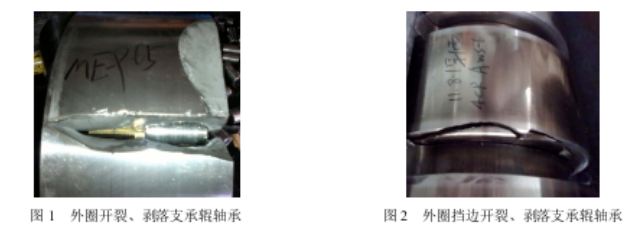
2 Cause analysis of the outer ring of back-up roll bearing bursting
2.1 Testing and analysis of bearing material and hardness
By comparing the hardness of the outer ring burst bearing and the normal bearing, no obvious abnormality was found, as shown in Table 1 and Table 2. The material was tested and compared. Under the microscopic structure, the martensitic structure on the outer diameter side and the raceway side showed good organizational condition. In addition, the interior was confirmed to have trotensite because it was meat thick, as shown in FIG. 3 and FIG. 4. Therefore, the follow-up focus on the bearing stress and bearing structure of the investigation and analysis.
The determination position is determined from the side of each part (the roller is the end face), and the surface hardness is determined as follows.
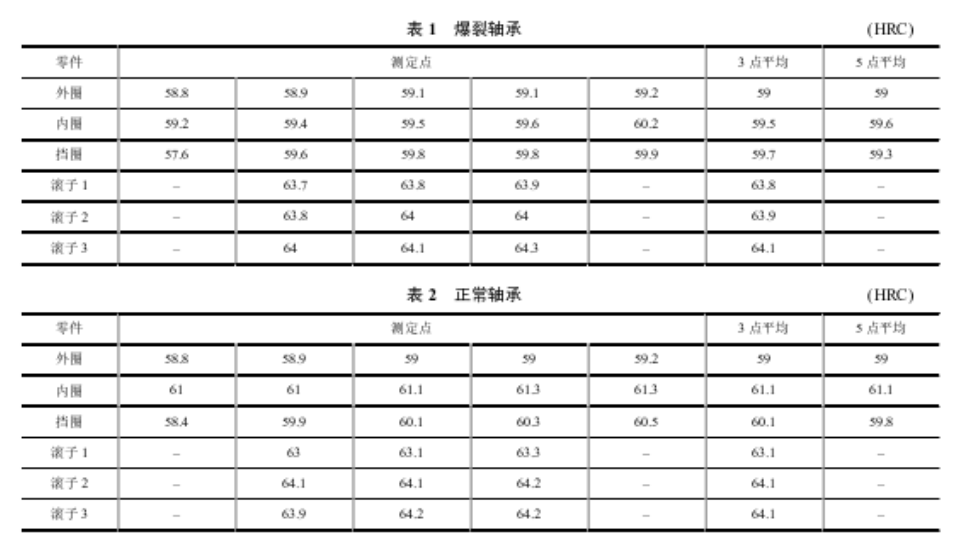
From the data analysis of the above two tables, the difference between burst bearings and normal bearings is that the surface hardness of the inner ring is different, and other parts, burst bearings and normal bearings have the same surface hardness. The outer ring, inner ring and retaining ring have a surface hardness of about 60HRC, and the roller has a high hardness of 64HRC.
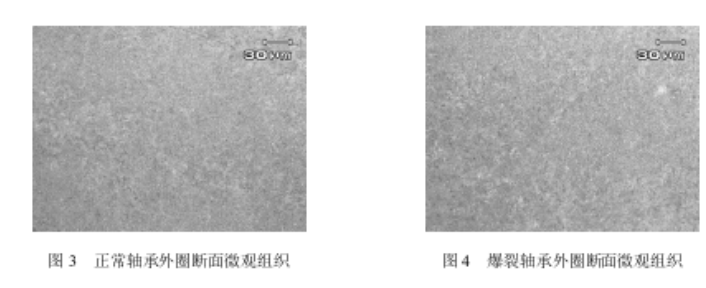
2.2 Force analysis
2.2.1 Load bearing analysis of the whole supporting roller
FIG. 5 shows the load borne by the whole back-up roll bearing and the contact force of the two rows of rolling elements and the inner and outer raceway of a single bearing. In the rolling process, the whole support roller bears the influence of deflection deformation, and the middle bearing 5 bears the greatest force. Considering that the deflection curvature of the central position accessory changes little, it can be approximated that bearing 5 is subject to uniform pressure. However, due to the bearing on both sides (especially 3, 4, 6, 7) due to the large change in deflection curvature, the force situation will change.
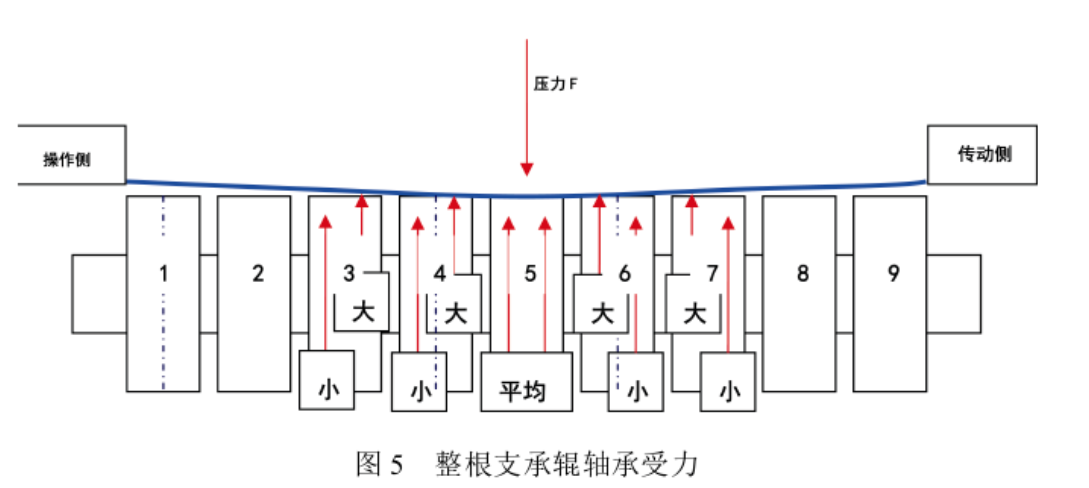
Take bearing 6 as an example. As shown in Figure 6, due to the influence of plastic deformation of bearing surface and rolling element, the deflection of mandrel will be much less than the two intermediate rollers. Therefore, the pressure F of bearing will be at a certain Angle to the mandrel. Therefore, after decomposition, the bearing will be subjected to an axial force F1 parallel to the direction of the mandrel, and the axial component F1 is offset by the bearing raceway side wall and guard edge. If the rolling force is too large or the crown design is unreasonable, the deflection of the back-up roll bearing will increase, and the axial component force F1 will increase. Once the component force F1 exceeds the bearing design bearing capacity, it will cause the end face of the rolling element, bearing side wall and retaining ring to wear, as shown in Figure 2, and finally spalling and cracking. At the same time, due to the existence of deflection, the force on both sides of the rolling body will be uneven, forming partial load, the side near the center of the force is larger, the side away from the center of the force is smaller, if the partial load is too large, it will lead to serious wear of the raceway on the off-load side, and even spalling and cracking. Finally tear the outer ring, as shown in Figure 7.
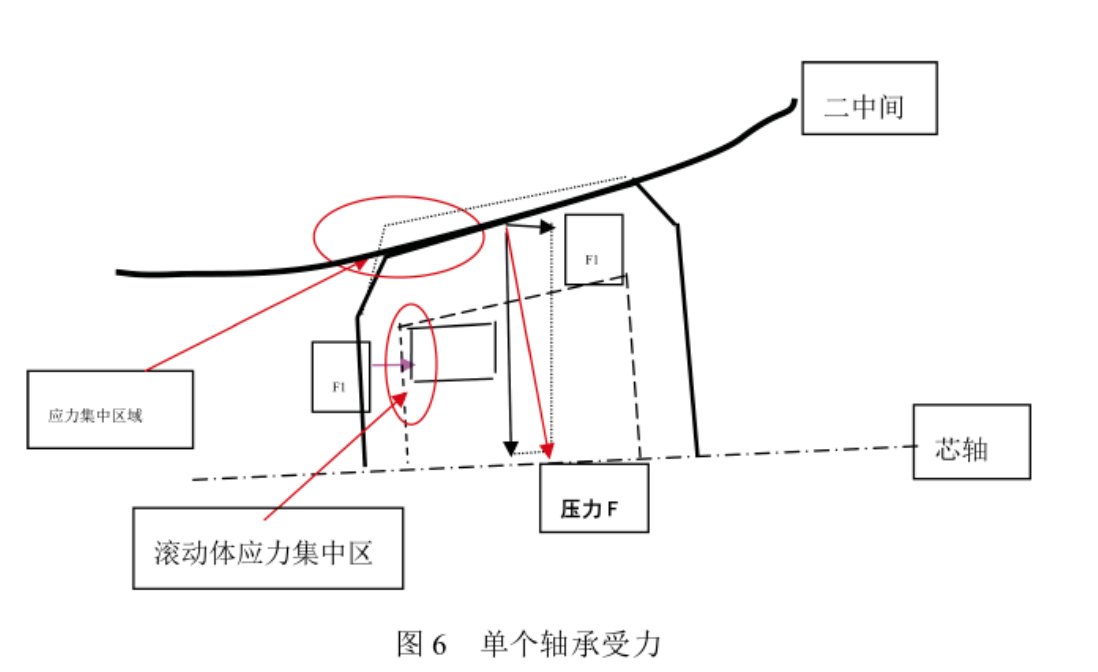
2.2.2 Force analysis of roll system
As shown in FIG. 8, if the height of the rolling line is inconsistent, the force of the whole roll system will be uneven, and the axial component force will be generated during rolling, which will cause the wear of the end face of the rolling element, the bearing side wall and the retaining ring when acting on the back-up roll bearing.
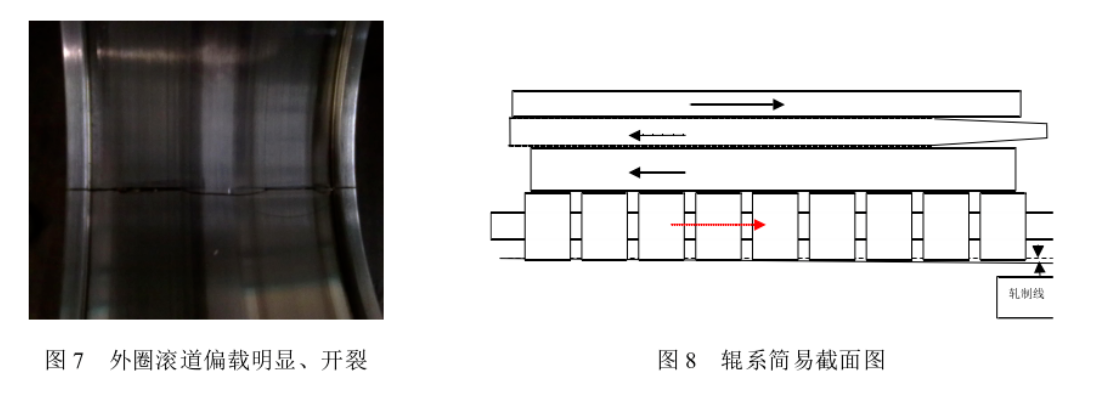
During the rolling process, the middle roll moves laterally, and the driving force will react on the two middle rolls through the friction force, and finally transfer to the back-up roll bearing. If an intermediate roll channeling force is too large, it may also lead to excessive axial force. Therefore, the friction during the movement should be reduced. Considering the uncontrollable pressure, the friction factor of one intermediate roll and two intermediate rolls should be minimized.
2.2.3 Analysis of rolling force
Table 3 shows the average data of the proportion of rolled steel grades in the normal rolling stage, abnormal rolling stage and each back-up roll bursting stage of the mill. It can be seen from the data in the table:
(1) The proportion of rolled steel has not changed greatly between normal stage and abnormal stage;
(2) Back-up roll bearing burst occurs more often in the rolling stage of 200/300 series steel, that is, the rolling force is larger.

2.3 Bearing structure analysis
At present, there are also bearing outer ring bursting problems in the rolling process of NSK and other imported bearings in the same type of 20-roll SUNDWIG rolling mill in the domestic stainless steel cold rolling plant, and the rolling condition is better than Baoxin, such as rolling force is smaller than Baoxin. Combined with the field working conditions, the bearing has been unable to withstand the rolling load of Baoxin SUNDWIG rolling mill, so the bearing structure is further analyzed.
2.3.1 Outer ring roll profile analysis
As shown in Figure 9, the 20-roll SUNDWIG rolling mill back-up roll bearings are distributed in two rows of rolling bodies. Since the roller surface of the outer ring of the bearing is designed to be horizontal in the middle and chamfered at both ends, theoretically, the stress area designed for a single back-up roll bearing is that the chamfer at both ends is inclined to the bearing center by 5~10mm (positions (1) and (3) in Figure 9 and Figure 10). The stress position corresponds to the chamfer area of the rolling element, and the superposition of the two places is not conducive to the service life of the bearing.
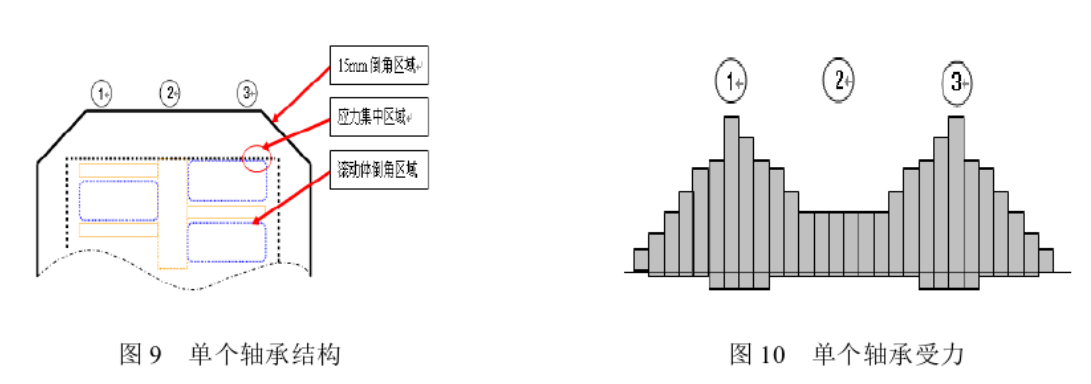
2.3.2 Analysis of outer ring structure
(1) Figure 11 is the schematic diagram of the outer ring structure. The outer ring is designed with a retaining edge, which is subjected to certain axial force during the rolling process. Long-term use will lead to wear and hair drawing of the end face of the rolling element and the end face of the retaining edge, and in serious cases, the retaining edge will burst and crack.
(2) The existence of the outer ring guard makes the inspection exist blind spots, the rolling body can not take out the outer ring raceway for a comprehensive and careful inspection, and the inspection of small spalling, small cracks and other defects will be missed, resulting in serious bursting, blocking and other production accidents.
(3) The thickness of the outer ring is 40mm, and its strength itself cannot meet the existing rolling conditions of Baoxin Company.
Based on the above analysis, the possible causes of SUNDWIG mill back-up roll bearing bursting are as follows:
(1) Abnormal force causes the back-up roll bearing to burst. Excessive rolling force, unreasonable crown design, rolling line inclination and excessive cross-over power of an intermediate roll may produce large axial force, which will cause transverse tearing of bearings if it exceeds the bearing bearing limit.
(2) Unreasonable design of bearing outer ring structure and roll shape causes the back-up roll bearing to burst. The chamfer stress concentration position of a single bearing outer ring overlapped with the chamfer position of the rolling element, resulting in weak bearing capacity at the chamfer position. The outer ring is designed with a retaining edge, which will cause wear, extrusion and cracking of the end face of the rolling body and the end face of the retaining edge when subjected to axial force, and it is inconvenient to check the use status of the raceway in the outer ring during maintenance, and there are maintenance blind spots.
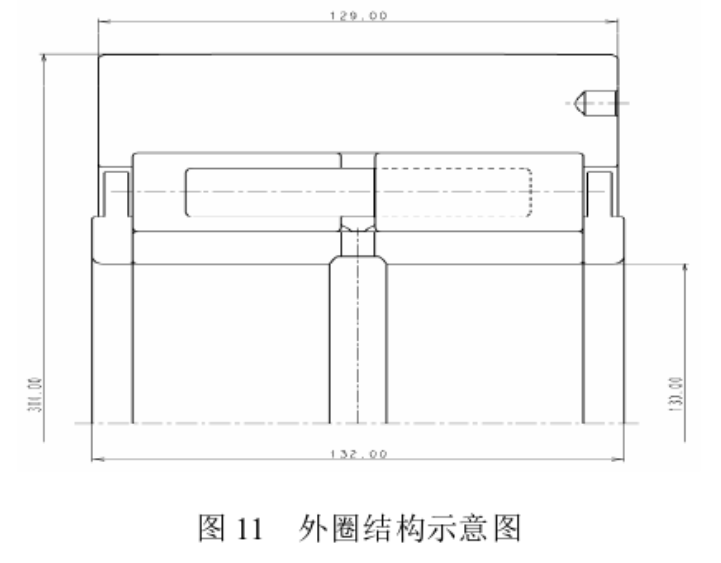
3 Solution
3.1 Improve bearing stress state
(1) When the pressure adjustment area of the bearing is under the machine, mark the position of the operating side and transmission side of the bearing, check the inner and outer rings of the bearing and the rolling body without abnormal, and reassemble the single bearing in the original position after the axial rotation of 180°. Avoid the one-sided rolling element and the inner and outer ring raceway long-term biased load situation, so that the two rows of rolling element and the inner and outer ring can get relatively uniform load during multiple uses.
(2) Adjust the rolling specifications of large rolling force steel (300 series and 200 series steel), specify its maximum reduction rate, minimum rolling thickness and rolling width, and adjust the reduction rate and pass distribution number of specific specifications.
(3) Adjust the moving speed of a middle roll of SUNDWIG rolling mill, improve the moving speed and the initial moving speed, and reduce the axial force in the whole rolling process.
(4) Increase the crown of the two intermediate idle rollers to compensate the deflection of the back-up rollers.
3.2 Improve bearing structure
(1) Adjust the roller shape of the bearing outer ring. While ensuring that the bearing outer diameter error is within the range of 10mm, the chamfer width of a single bearing is increased, adjusted from the original 15mm to 20mm, and the slope is unchanged. Although the bearing surface is reduced and the bearing ability to bear load is reduced, theoretically the stress concentration in the outer chamfered area and the outer raceway surface can be reduced after the rolling body produces plastic deformation, so that the two rows of rolling body and the inner and outer raceway are more evenly stressed, thus reducing the probability of cracking of the bearing outer ring.
(2) Improve bearing structure and heat treatment method. Since the outer dimension of the bearing cannot be changed, its main failure form is the outer ring burst, and the bearing capacity and service life of the outer ring can only be improved from the internal structure of the bearing. The main change is that the wall thickness of the outer ring increases, and the diameter of the inner ring and rolling element decreases. It adopts the form of middle flange to facilitate maintenance inspection and discharge of spalling particles inside the bearing. On this basis, the heat treatment process of the outer ring is improved to improve the impact toughness and fracture toughness of the bearing, and the inner raceway surface of the outer ring is carburized to improve the surface fatigue resistance. The improved bearing is shown in Figure 12.
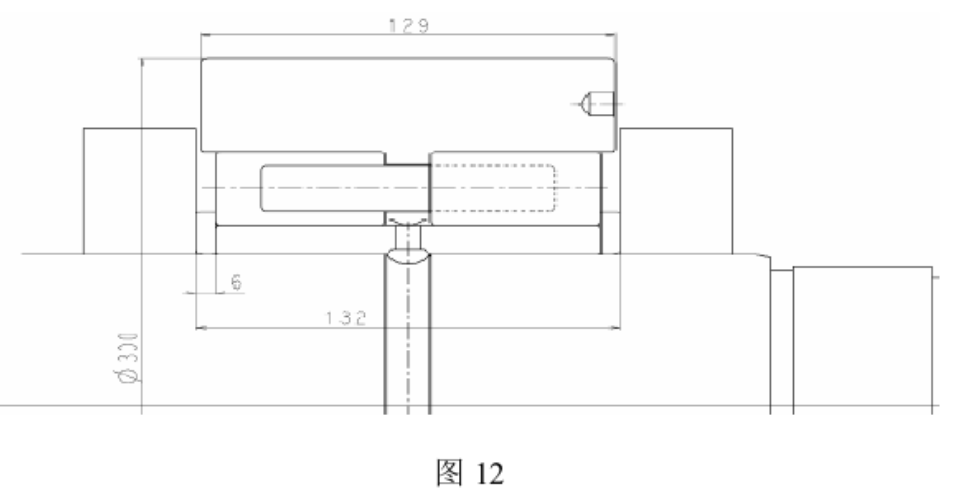
3.3 Ensure assembly quality
During assembly and maintenance, check the raceway, rolling body, guard edge and cage of the bearing itself, and purge the mandrel and lubrication hole with compressed air to remove foreign matter.
4 Verify the actual usage
After improving the stress state and lubrication condition of SUNDWIG mill back-up roll bearings, the average monthly times decreased from 2.2 times before improvement to 0.51 times after six months of tracking. After the improvement of bearing structure, after half a year of tracking, the SUNDWIG mill back-up roll bearing burst completely avoided, the effect is very significant.
5 Conclusion
The main reasons for the outer ring burst in the use of the 20-roll SUNDWIG rolling mill back-up roll bearings are as follows: First, the axial force of the bearing is greatly increased after the rolling force is increased, resulting in the wear of the bearing rolling element and the bearing outer guard edge is intensified until it bursts; Second, the bearing structure design is unreasonable, the existence of the outer ring retaining edge and the wall thickness is insufficient, leading wear and cracking occur under the condition of large axial force. In this regard, according to the actual environment of the production site, the corresponding improvement measures are put forward, and the problem of bearing bursting of the back-up roll of the 20-high SUNDWIG rolling mill is completely solved through the actual use verification.
【 Reference 】
[1] Liu Zejiu, He Shiquan, Li Xinglin, et al. Rolling body Bearing Application Manual [M]. 3rd edition. Beijing: China Machine Press, 2014.
[2] Yu Fumei. Damage Forms and Countermeasures of Back Bearing of 20-high Rolling Mill [J]. Science and Technology Entrepreneur, 2012.